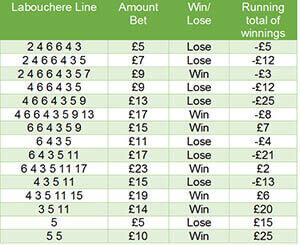Labouchere System
The Labouchere system has some progressive elements, but is more complex than the Martingale and Fibonacci systems. It is an unusually interactive system that can be enjoyable to play, and beyond roulette, has applications in many other casino games.
The system is named after nineteenth-century British aristocrat, Henry Labouchere, who was a politician, journalist and avid gambler. His particular passion was roulette and he became famous for developing an elegant roulette betting strategy that is still used by roulette players today.
By Adiela de Bruyn - Last modified 2024/02/08 - Estimated reading time: 3 minutes.
Table of contents

How does it work?
The system is designed to work with even money binary bets such as Red/Black and Even/Odd. To start with, you have to decide how much money you want to win, and you then have to divide that amount up into smaller figures that add up to your total. The make-up of your sequence is entirely down to you. For example, if you decided that you want to earn R100, you could make a sequence of 10 10 10 20 20 20 10.
These numbers are then used to determine the size of your bet. To come up with your first stake, you add the leftmost and rightmost numbers together, which in this case is 2, so your first bet will be R20. If your bet wins, you cross out the two numbers you just used. In this case, the new sequence would read: 10 10 20 20 20. If your bet loses, you add the number that you just bet with to the right side of the sequence: 10 10 10 20 20 20 10 30 and continue to bet. The aim is to bet until all of the numbers are crossed out.
Variations & Modifications
One of the pleasing aspects of the Labouchere strategy is its flexibility. Once you are used to working with it, you can try out some of the many variations that exist, or come up with your own. For instance, you could make the initial sequence safer by using a variation known as the Johnson Progression, which gives a sequence of nine zeroes followed by a one. You might decide to split the stake in the event of a losing bet, only adding half of it to the right side of the sequence. There is also an ultra-safe option known as the Reverse Labouchere, under which you increase stakes when you win and reduce them when you lose.
Pros and Cons
Although it has some progressive elements, the Labouchere system does not involve such a dramatic increase in the stake level as you get with systems such as the Martingale, and makes it easier to handle the inevitable losing runs. It also offers a degree of interactivity and judgement, because you are required to set your desired winning amount, and divide it up into sequences of numbers, which you then tick off. This can be fun to do and can make a game of roulette much more enjoyable.
While the Labouchere System, particularly in its Reverse variation, does a good job of minimizing risk and losses, in theory, it is possible to experience long losing runs, which can lead to players being forced to bet larger and larger proportions of their bankroll. Some players may also find the system of numbers a little fiddly. That said, the system does a good job of minimizing losses and offers an elegant solution for roulette players.







